The Dell XPS 15 9550 Review: Infinity Edge Lineup Expands
by Brett Howse on March 4, 2016 8:00 AM ESTCompute
The XPS 15 is not marketed as a gaming laptop, and while any gaming laptop can pull double duty, people buying the XPS 15 may not be interested in gaming at all. The GPU can still be leveraged for certain workloads such as photo and video editing. The parallel computing power of the GPU makes it a great choice for these types of tasks.
CompuBench
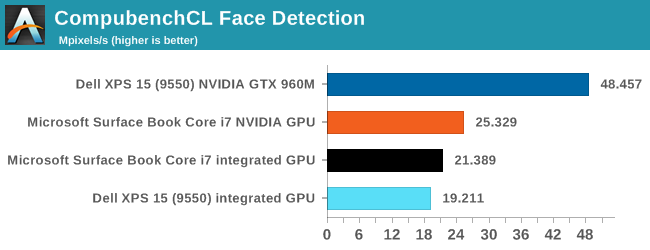
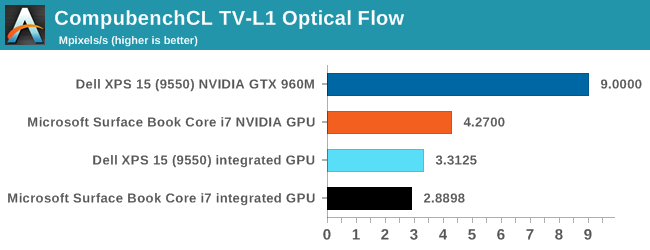
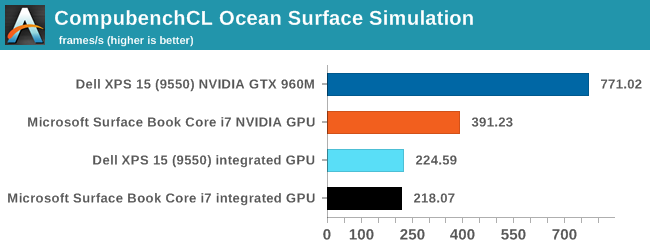
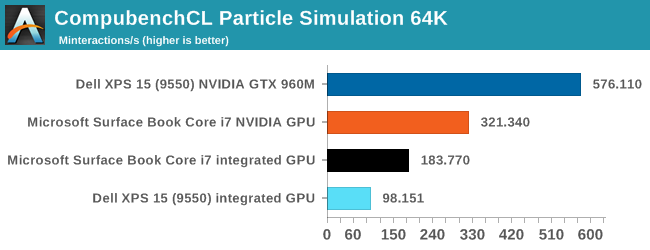
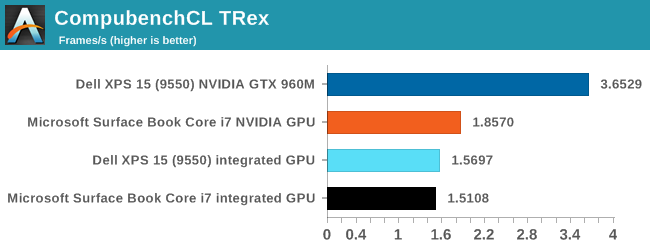

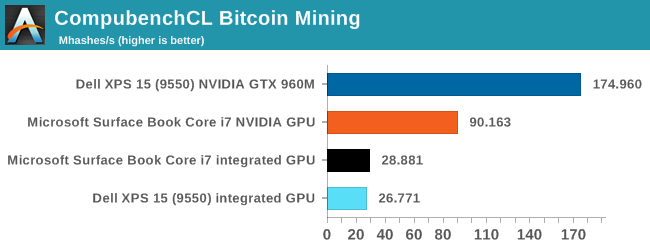
The only other device we’ve tested with Kishonti’s CompuBench is the dGPU version of the Surface Book. I felt it would be a nice comparison to see just how much more performance the GTX 960M would give in compute tasks. Compared to just integrated graphics, there is a big jump in performance from both of the discrete cards, but the GTX 960M is roughly double the performance of the GT 940M in the Surface Book. If you need compute power, you get a lot more in the XPS 15 with the quad-core processor and much more powerful GPU.
Storage Performance
Dell does offer the XPS 15 with a mechanical hard drive as the baseline option, but once you step up a couple of tiers it can be outfitted with a PCIe based SSD, and in the case of our review unit it is the Samsung PM951. This has become incredibly popular it seems, since it lets companies check the box beside PCIe on storage, but unfortunately it is a TLC based drive so write speeds aren't as high as what we've seen MLC-based PCIe drives do. Clearly Samsung is aggressive with the pricing on this drive since it is in pretty much every device we’ve seen that has PCIe storage.
Recently PCMark 8 updated their testing for storage to better differentiate drives with NVMe storage. As such, the existing scores are no longer comparable with those from the new suite. The XPS 15 scored 5036 in the new test, but we'll need more devices tested in order to have something to compare it to.
Despite the TLC NAND, Dell shipped the 512 GB version of the XPS 15, so it has enough NAND dies to help the write speeds through parallel work, keeping even this slower TLC drive performant over short bursts. I actually expected read speeds to be a bit higher as well but over 800 MB/s is still faster than what SATA drives can do.


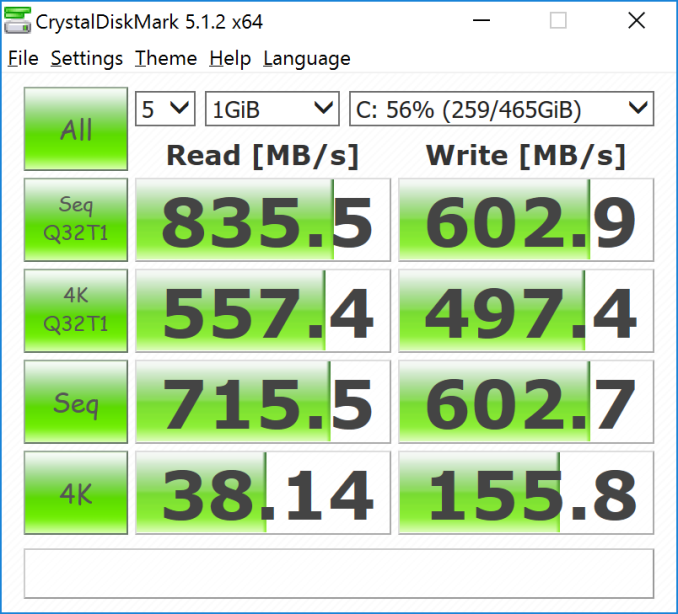








152 Comments
View All Comments
nerd1 - Monday, March 7, 2016 - link
Installing linux on latest hardware is generally a nightmare... which distro are you using? Do they now (finally) support switchable graphics and hi-dpi display?cpoole - Monday, March 7, 2016 - link
not sure about rstuart but I am running ubuntu-gnome 15.10 with kernel 4.4 built from intel DRM nightlies and I have almost 0 problems with the laptop. Hi-dpi works great and if you're running the nvidia proprietary drivers turning the gpu on and off with the nvidia tweak tool is a breeze... although I havent used it for anything other than a cuda demo.nils_ - Tuesday, March 8, 2016 - link
Switchable graphics do work on a per-program basis but it's a hassle. Makes the NVidia chip pretty much a waste. Everything else is due to Intel being slow to get their drivers into the kernel and distributions running on outdated, sometimes self-maintained kernel versions.So yeah it now sucks a bit more than t used to.
eightspancrow - Monday, March 7, 2016 - link
There's a lot of complaints about the photo quality which I get but - why would you use a 4:3 wallpaper as your cover photo on a laptop specifically featuring an ultra small bezel? It's kind of mystifying because then the black fill..... looks like a huge bezel. This is currently the featured article on the front page and it makes something that honestly looks pretty futuristic/cool into what looks like somebody's office computer.dsumanik - Monday, March 7, 2016 - link
I stand by my original statement, the readers around here are now more informed than the editorial/review staff. No amount of excuse making will change this. In the past Anand (the person) worked with manufacturers on a regular basis to identify and correct issues like the one pointed out with this machine. We will never hear of a resolution to this problem on this website, unless it is in the comment section. And yes, if you are in the business of reviewing products, it IS your responsibility to investigate the issue...a simple check on the forums and a warning paragraph would have sufficed, you'd think the reviewers would haver a checklist to follow by now lol.nils_ - Tuesday, March 8, 2016 - link
I really like the infinity display, other than that I could do without the GTX960M (give me Iris Pro instead) and I don't need a touch screen. Would be great to have more BTO options.TraciR - Tuesday, March 8, 2016 - link
Why put the XPS 13 keyboard in the bigger XPS15?This is design laziness from Dell. I have an XPS 13, and miss the proper key layout, but perhaps it wouldn't fit.
PgUp, PgDn and bigger arrow keys are a must. Look at Lenovo for how to do a laptop keyboard.
Valantar - Wednesday, March 9, 2016 - link
Am I the only one who would want a dGPU-less (but preferably Iris/Iris Pro-powered) version of this? Slightly slimmer (if possible), same battery size, and a QHD display. And external GPU support through TB3, of course.nils_ - Wednesday, March 9, 2016 - link
nope. I don't need dedicated graphics in a laptop.Valantar - Saturday, March 12, 2016 - link
Exactly. Dedicated graphics add too much power draw for too little gain outside of humongous gaming "laptops." A good iGPU and the option of external graphics through TB3 (either with a desktop class chassis or a dock/slice/brick style mobile GPU with it's own battery) is all anyone would need in a device like this.